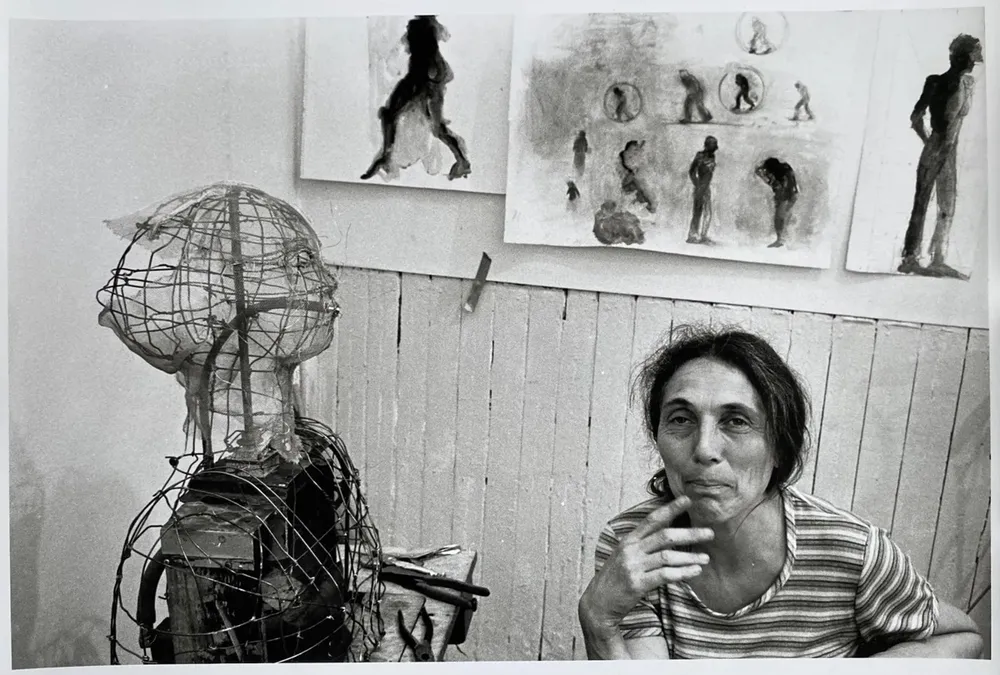June Leaf, an influential American visual artist renowned for her abstract allegorical paintings, drawings, and modernist kinetic sculptures, passed away on July 1, 2024, at the age of 94. Based in New York City and Mabou, Nova Scotia, Leaf’s work spanned decades and defied easy categorization, leaving an indelible mark on the art world.
Leaf’s artistic style was unclassifiable, characterised by a wide array of forms and themes. Her works ranged from off-kilter reinterpretations of famous art-historical images to surreal monuments dedicated to women and mechanized sculptures depicting confined figures. Despite the acclaim her work often received, Leaf never conformed to the dominant artistic trends of her time, prioritizing her unique vision over widespread recognition.
Commitment to the Human Figure
Central to Leaf’s art was her dedication to the human figure. Even when abstraction was the favoured mode of expression, Leaf’s work remained grounded in figuration. Critic Barry Schwabsky once remarked that Leaf’s genius lay in her commitment to creating images, drawing a lineage from artists like Giacometti and Picasso to the primal urge to depict the human form.
Early Life and Education
Born in Chicago on August 4, 1929, Leaf’s artistic inclinations emerged early. At three years old, she asked her mother to draw a shoe, sparking a lifelong passion for drawing. At 18, she attended the Institute of Design at the Illinois Institute of Technology, where she learned experimental drawing techniques from artist László Moholy-Nagy. However, more interested in the visiting artists than the coursework, Leaf left the institute to pursue her own artistic path.
Paris and Early Recognition
In 1948, Leaf travelled to Paris, where her work began to garner attention. She embarked on experimental projects, including a painting on the tiles of a bathtub. Though some questioned her mental health, a psychiatrist ‘confirmed her sanity’, and she continued to develop her distinctive style.
Return to the United States and Further Education
Returning to Chicago, Leaf’s work attracted the attention of prominent artists like Leon Golub. She completed her MA at the Institute of Design in 1954 and later received a Fulbright grant to return to Paris. There, she took life classes at the Louvre, although she felt inadequate compared to the Old Masters she copied.
In 1965, Leaf created her first sculpture, Vermeer Box, a three-dimensional re-creation of a Vermeer painting with contemporary elements. This marked a significant shift in her artistic practice, leading her to explore tactile experiences and new dimensions in her work. Her sculptures, often interactive and kinetic, invited viewers to engage with them, blurring the lines between art and life.
Personal Life and Career in Nova Scotia
Leaf married renowned photographer and filmmaker Robert Frank in 1971. Together, they made a home in Mabou, Nova Scotia, where they lived and worked for the rest of their careers. Despite a survey at the Museum of Contemporary Art Chicago in 1978, Leaf’s work did not receive widespread recognition until later years, with a notable 2016 retrospective at the Whitney Museum of American Art.
Artistic Legacy
Leaf’s art was a continuous exploration of new ways of seeing the world. Her sculptures, often resembling eyeglasses but designed to distort rather than clarify vision, exemplified her inventive spirit. She once described herself as an inventor, always seeking new forms of expression.
Awards and Recognition
Throughout her career, Leaf received numerous accolades, including honorary doctorates from DePaul University and the Nova Scotia College of Art and Design. She was also awarded the Distinguished Artists Award from the Canadian Council and a National Endowment for the Arts grant in painting.
June Leaf’s death marks the end of an era for an artist whose work continually pushed boundaries and challenged conventions. Her dedication to the human figure, combined with her innovative spirit, leaves a lasting legacy in the art world. Leaf’s works remain a testament to her belief in the transformative power of art and her relentless pursuit of new ways to understand and depict the human experience.

